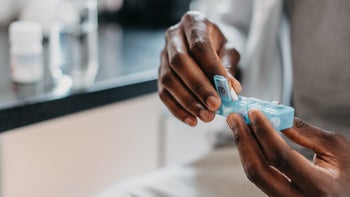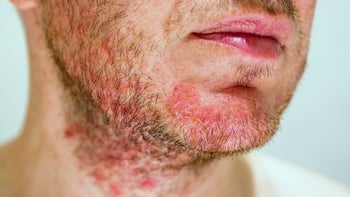
What Does Stasis Dermatitis Look Like? Here Are Images to Help
Key takeaways:
Stasis dermatitis is a chronic skin rash caused by pooling of fluid in the lower legs.
Leg swelling (edema) leads to discolored, dry, cracked, and itchy skin. When severe, blisters and ulcers may also occur.
Treatment of stasis dermatitis involves decreasing edema in the legs, practicing good skin care, and taking preventive action.
Table of contents

Rashes are no fun. And there are many different types with a wide range of causes. You might already know that allergic reactions and infections can cause rashes. But did you know that leg swelling can also cause skin changes? This is what happens in stasis dermatitis.
“Stasis” means staying still or pooling. “Dermatitis” is a fancy word for a rash, meaning skin inflammation. So, stasis dermatitis is a skin rash caused by pooling of fluid (edema) in the lower legs. This is a common condition that affects about 6% of people over the age of 65. And it can be pretty uncomfortable.
What causes stasis dermatitis?
In general, stasis dermatitis happens when circulation in the legs isn’t working as well as it should. This causes fluid to leak from the blood vessels into the surrounding skin.
Search and compare options
To understand why stasis dermatitis happens, it helps to understand veins and edema. Veins are thin blood vessels that return blood to the heart. When you sit or stand, veins fight an uphill battle to return blood from the legs to the heart. Valves inside of the veins help prevent backflow of blood, and leg muscles help squeeze blood uphill.
However, vein valves get leakier with age. And if you don’t move around much, leg muscles don’t help squeeze blood uphill. Fluid can then pool in the legs, causing edema.
Chronic venous insufficiency is when edema is caused by veins that don’t return blood to the heart well. And some people with this condition can develop stasis dermatitis.
It’s not clear why some people with chronic venous insufficiency get stasis dermatitis and some don’t. But we do know that stasis (pooling) creates high pressure in veins, triggering inflammation, which leads to skin changes.
Who is most at risk for stasis dermatitis?
Age is one of the biggest risk factors for stasis dermatitis because valves in veins don’t work as well over time. People over 50 — especially women — are most likely to develop stasis dermatitis.
Anything that causes prolonged pooling of fluid in the legs can also raise the risk of stasis dermatitis. This includes:
A BMI (body mass index) of 30 or higher (“obese” category)
A sedentary lifestyle (lack of physical activity)
Long periods of sitting or standing (like for a job, such as truck driving)
A history of injuries to or surgeries on the legs, especially when veins are involved
A history of blood clots (deep vein thrombosis)
Stasis dermatitis images
Stasis dermatitis can look a bit different depending on the color of your skin. And there can be different degrees of swelling. Let’s take a look.




What are the symptoms of stasis dermatitis?
Stasis dermatitis typically affects the feet, ankles, and/or lower legs. It can affect just one side of both. In rare cases it affects other parts of the body, too.
But edema and rash are always present. That’s because you can’t have stasis dermatitis without stasis and dermatitis. The rash may look red or brown in lighter skin tones. And it may look purple, brown, gray, or ashen in darker skin tones.
Other symptoms of stasis dermatitis include:
Thick, dry, scaly skin
Blisters that ooze or leak fluid
Sores or ulcers
Itching
Wide, puffy, visible veins (varicose veins)
Aching, burning, or tight-feeling legs and feet
What are complications of stasis dermatitis?
When severe, stasis dermatitis may cause venous ulcers (open sores). Since circulation is poor, venous ulcers take a long time to heal and often need special care. Stasis dermatitis may also lead to skin infection (cellulitis), especially if there are openings in the skin.
How do you diagnose stasis dermatitis?
Medical professionals can typically diagnose stasis dermatitis just by looking at it. When someone has edema and a discolored, dry, scaly rash, the diagnosis is fairly straightforward. “Sock lines” — indentations in the skin from your socks at the end of the day — are also an easy clue for edema.
How do you treat stasis dermatitis?
Treatment of stasis dermatitis involves three parts:
Decreasing fluid pooling in the legs
Caring for the skin
Taking preventive steps
Decreasing fluid pooling in the legs
To decrease fluid pooling in the legs, a medical professional might recommend:
Compression garments, which help squeeze fluid back into the veins and return blood to the heart
Diuretics (water pills), like furosemide (Lasix)
Low-salt diet, since salt makes the body hold onto fluid
Propping up your feet on pillows (above the heart) while sitting or sleeping to help return fluid to the heart
Increasing your physical activity level
Getting up for a brisk walk after sitting or standing for more than 1 hour at a time
Caring for skin
Skin affected by stasis dermatitis is dry, inflamed, itchy, and uncomfortable. Keeping the skin moisturized and avoiding scratching are critical to healing and preventing issues.
To care for skin affected by stasis dermatitis, your care team might recommend:
Bathing with mild, fragrance-free cleansers instead of harsh soaps
Using a soft bath sponge or towel instead of something rough or exfoliating
Gently patting the skin dry after bathing
Applying petroleum jelly within 2 minutes of bathing to skin that’s slightly damp
Wearing loose-fitting cotton pants that won’t rub or irritate the skin
Avoiding injuring the area
If your skin is very inflamed, your provider might prescribe a steroid cream, like hydrocortisone. And if you have a skin infection, you may need antibiotics.
Prevention
Stasis dermatitis can be uncomfortable, and it can be embarrassing for some. But there’s a lot you can do to prevent it or keep it from getting worse, including:
Maintaining a healthy weight for you
Reviewing your medications with your healthcare provider to see if any might be adding to leg swelling
The bottom line
Stasis dermatitis is a common long-term skin condition caused by chronic leg swelling. The best way to prevent stasis dermatitis is to remain physically active and maintain a healthy weight. But if you have stasis dermatitis, there’s a lot you can do to prevent complications and lessen swelling and rashes.
Why trust our experts?



Images used with permission from VisualDx (www.visualdx.com)
References
American Academy of Dermatology Association. (n.d.). Eczema types: Stasis dermatitis self-care.
American Academy of Dermatology Association. (n.d.). Eczema types: Stasis dermatitis signs and symptoms.
Johns Hopkins. Medicine. (n.d.). Venous ulcers.
National Eczema Association. (n.d.). Stasis dermatitis.
Sundaresan, S., et al. (2017). Stasis dermatitis: Pathophysiology, evaluation, and management. American Journal of Clinical Dermatology.
Yosipovitch, G., et al. (2023). Stasis dermatitis: An overview of its clinical presentation, pathogenesis, and management. American Journal of Clinical Dermatology.

























